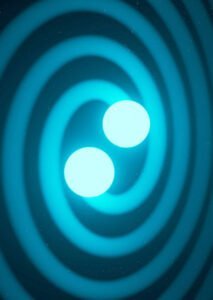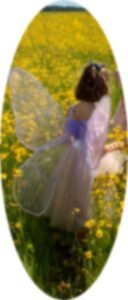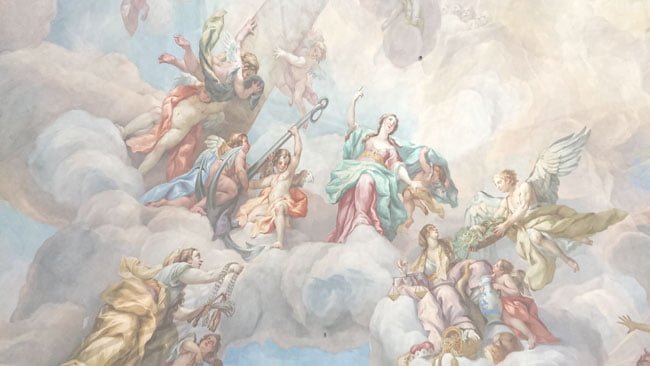We all create hypotheses and theories about life which we then test. If a hypothesis proves useful and make good sense of our experience, well then we adopt it as real. A hypothesis that leads to poor life outcomes and predictions is discarded.
This is the way of scientists and babies and all humans beings in-between. Dogs and viruses both fall into the successful hypothesis category. A dog is a symbolic mental representation of a vast array of information and sensation that the child receives from the world. The child creates and projects an image of a dog onto this information which we are all agreed looks nothing like a dog because it is just a chaotic mix of sound waves, light waves, smells, textures etc. There is nothing in the baby’s direct primary experience that is a dog. The creative imagination principle is hard at work in the small baby creating a sensible world for it to live in.
 A virus is a much more complicated abstraction following similar principles. No-one has actually seen a virus, it’s far too small. The scientist may interpret the impressions seen through an electron microscope as viruses, but this requires collusion in all sorts of other theories and world views. A virus was simply a hypothesis, which did well at explaining the facts and making good predictions, so now we think viruses are real, because life makes more sense if they exist. There is no way of proving that they are real, because its hard to even understand what that would mean. The theory of viruses depends on a bewildering array of other scientific theories to make any sense at all. Dogs are a more straightforward concept.
A virus is a much more complicated abstraction following similar principles. No-one has actually seen a virus, it’s far too small. The scientist may interpret the impressions seen through an electron microscope as viruses, but this requires collusion in all sorts of other theories and world views. A virus was simply a hypothesis, which did well at explaining the facts and making good predictions, so now we think viruses are real, because life makes more sense if they exist. There is no way of proving that they are real, because its hard to even understand what that would mean. The theory of viruses depends on a bewildering array of other scientific theories to make any sense at all. Dogs are a more straightforward concept.
There is no doubt we create the realities we live in. Most of us have no problem with this idea. The realities we create are constrained by how useful they are, which depends on how well they represent the world out there in which we have to stay alive.
The world out there, as it is, is beyond our grasp, because all conscious experience is mediated through our minds. The world out there as it is, is something like a bewildering array of energy potentials, or at least this is what the physical sciences might say.
 We are social animals, and so the worlds we create needs to be closely aligned to those of our social group. Maybe a child sees fairies, puts together this image from the information it senses, but without recognition from others the image becomes irrelevant and is quickly discarded. Fairies disappear.
We are social animals, and so the worlds we create needs to be closely aligned to those of our social group. Maybe a child sees fairies, puts together this image from the information it senses, but without recognition from others the image becomes irrelevant and is quickly discarded. Fairies disappear.
Of course the images and concepts we fix to build our worlds aren’t arbitrary, however I’m sure there are many good possibilities that we fail to see or engage with, because the conventional wisdom of the day is not interested. In a sense they no longer exist, because no-one is imagining them anymore.
So what happened to the angels that have accompanied humans for thousands of years. Judaism, Christianity, and Islam all had angels. Angels were intermediaries between God (that of which we cannot speak) and man. Superior to humans in power and intelligence, they were our guardian protectors and guides.
I can certainly imagine angels. I can create a vivid deeply felt image of their beauty, power, intelligence and concern for my welfare. I can make them seem real. I can develop a personal relationship with them so that my life becomes richer – I feel more supported, heard and loved – and it is surprisingly easy for me to do this … it’s like my organism knows about angels.
Belief in angels is belief in a deeper part of myself that is all around me and more beautiful, beneficent and wiser than I believe myself to be.
What I find curious in my investigation of angels, is that even though I believe them to have an existence outside me in a finer realm, I discover them by going deep within myself, by looking within.
Psychologists may dismiss these realms and their beings as but a projection of inner states of feeling. But maybe the inner and the outer aren’t different. Life may not be as compartmentalised as they would have it be. Maybe it is not a case of mistaken identity as the psychologist would say but one of identity.
I venture into inner subtle realms within in order to understand my relationship to the greater whole outside of me. I discover my guardian angel by exploring and sensing within myself, even though I conceive of angels as being outside of me. This is the wisdom of alchemy. As above so below. The world is not as it seems. The inner and the outer are one.
The angels are not physical and neither are my inner experiences. This is not a coincidence.
If we need something that would improve our lives markedly then angels would do it. I can’t point to an angel, but I can’t point to a virus or a feeling either. This hypothesis would pass all the markers of being useful, improving my life, increasing my sense of well being. But are they actually real? This question doesn’t really make sense. Neither virus’s nor angels are true, or real in the way we think. They are models and concepts that help to make our lives more understandable, predictable and better.
We threw God and the angels away, thinking we were getting freedom, rationality and the power of the individual in return. Instead our lives became two dimensional and impoverished as a result.
Let’s bring the angels back.




